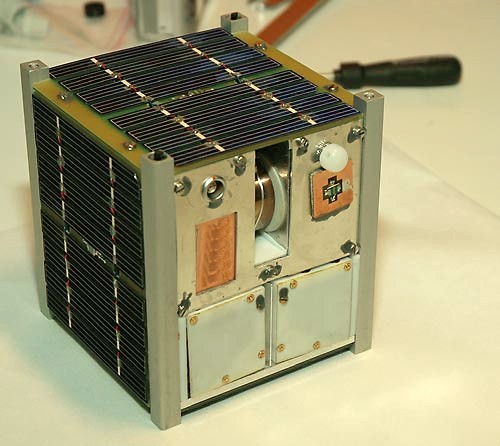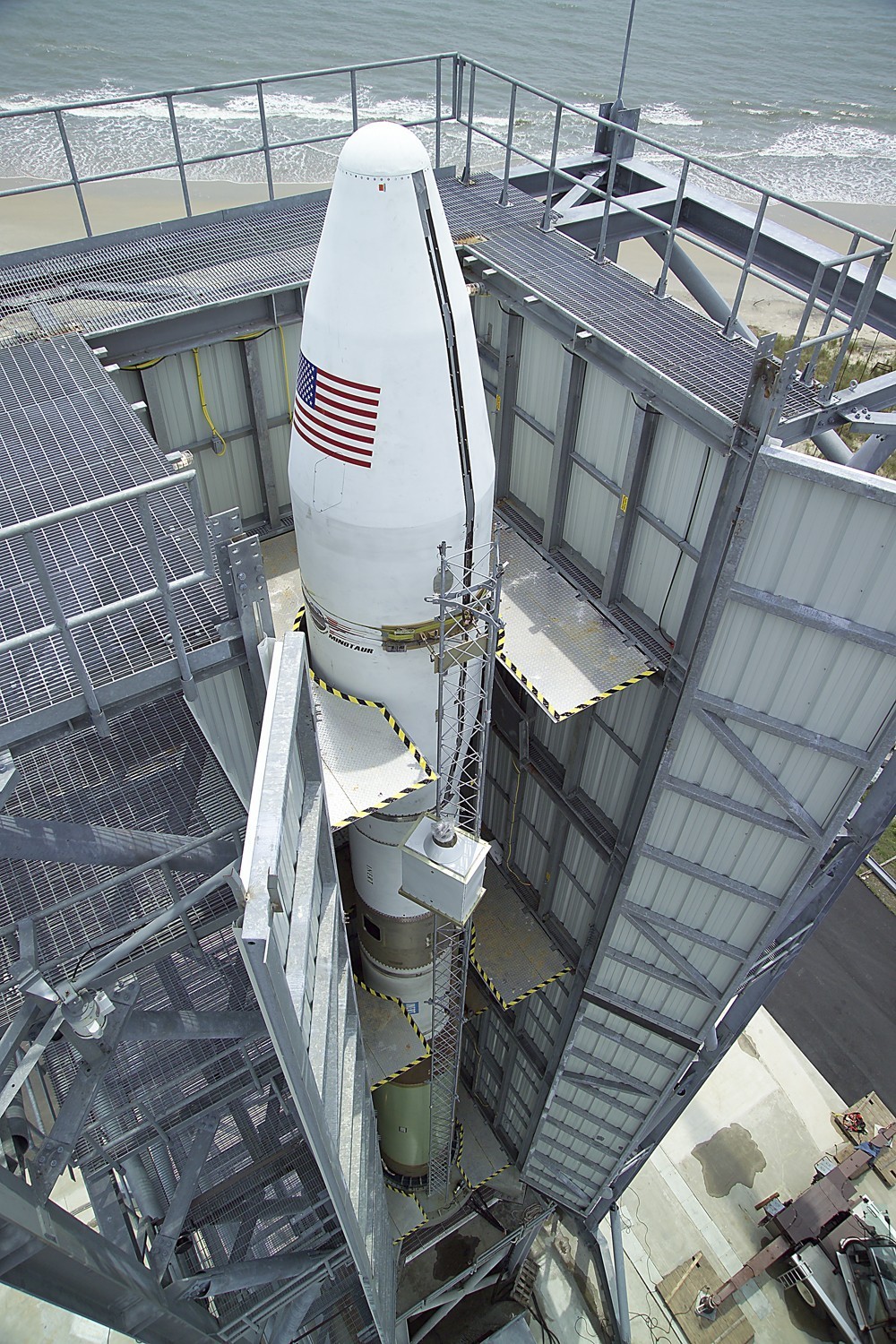|
GeneSat-1
GeneSat-1 is a NASA fully automated, CubeSat spaceflight system that provides life support for bacteria E. Coli K-12. The system was launched into orbit on 16 December 2006, from Wallops Flight Facility. GeneSat-1 began to transmit data on its first pass over the mission's California ground station. The nanosatellite contains onboard micro-laboratory systems such as sensors and optical systems that can detect proteins that are the products of specific genetic activity. Knowledge gained from GeneSat-1 is intended to aid scientific understanding of how spaceflight affects the human body. Weighing 4.6 kilograms, the miniature laboratory was a secondary payload on an Air Force four-stage Minotaur 1 launch vehicle that delivered the Air Force TacSat-2 satellite to orbit. In the development of the GeneSat satellite class (at a fraction of what it normally costs to conduct a mission in space), Ames Research Center The Ames Research Center (ARC), also known as NASA Ames, is a m ... [...More Info...] [...Related Items...] OR: [Wikipedia] [Google] [Baidu] |
CubeSats
A CubeSat is a class of miniaturized satellite based around a form factor consisting of cubes. CubeSats have a mass of no more than per unit, and often use commercial off-the-shelf (COTS) components for their electronics and structure. CubeSats are put into orbit by deployers on the International Space Station, or launched as secondary payloads on a launch vehicle. , more than 1,600 CubeSats have been launched. In 1999, California Polytechnic State University (Cal Poly) professor Jordi Puig-Suari and Bob Twiggs, a professor at Stanford University Space Systems Development Laboratory, developed the CubeSat specifications to promote and develop the skills necessary for the design, manufacture, and testing of small satellites intended for low Earth orbit (LEO) that perform a number of scientific research functions and explore new space technologies. Academia accounted for the majority of CubeSat launches until 2013, when more than half of launches were for non-academic purposes, a ... [...More Info...] [...Related Items...] OR: [Wikipedia] [Google] [Baidu] |
Ames Research Center
The Ames Research Center (ARC), also known as NASA Ames, is a major NASA research center at Moffett Federal Airfield in California's Silicon Valley. It was founded in 1939 as the second National Advisory Committee for Aeronautics (NACA) laboratory. That agency was dissolved and its assets and personnel transferred to the newly created National Aeronautics and Space Administration (NASA) on October 1, 1958. NASA Ames is named in honor of Joseph Sweetman Ames, a physicist and one of the founding members of NACA. At last estimate NASA Ames had over US$3 billion in capital equipment, 2,300 research personnel and a US$860 million annual budget. Ames was founded to conduct wind-tunnel research on the aerodynamics of propeller-driven aircraft; however, its role has expanded to encompass spaceflight and information technology. Ames plays a role in many NASA missions. It provides leadership in astrobiology; small satellites; robotic lunar exploration; the search for habitable planets; s ... [...More Info...] [...Related Items...] OR: [Wikipedia] [Google] [Baidu] |
Minotaur (rocket Family)
The Minotaur is a family of United States solid fuel launch vehicles derived from converted Minuteman and Peacekeeper intercontinental ballistic missiles (ICBM). They are built by Northrop Grumman via contract with the Air Force Space and Missile Systems Center's Space Development and Test Directorate (SMC/SD) as part of the Air Force's Rocket Systems Launch Program which converts retired Intercontinental Ballistic Missiles into space and test launch systems for U.S. government agencies. Three variants of the Minotaur are currently in service. The Minotaur I is an orbital launch system used to launch small satellites into low Earth orbit (LEO). The Minotaur II is a target launch vehicle (TLV), also known as Chimera, used for suborbital flights, often as a target for tracking and anti-ballistic missile tests. The Minotaur IV is a more capable LEO launch system. The Minotaur V is designed to reach higher orbits, including geostationary transfer orbit (GTO) and trans-l ... [...More Info...] [...Related Items...] OR: [Wikipedia] [Google] [Baidu] |
Mid-Atlantic Regional Spaceport
The Mid-Atlantic Regional Spaceport (MARS) is a commercial space launch facility located at the southern tip of NASA's Wallops Flight Facility on Wallops Island in Virginia, just east of the Delmarva Peninsula and south of Chincoteague, Virginia, United States. It is owned and operated by the Virginia Commercial Space Flight Authority. Background The Virginia General Assembly created the political subdivision Virginia Commercial Space Flight Authority (VCSFA), also known as Virginia Space, in 1995 to promote the development of the commercial space flight industry, economic development, aerospace research, and Science, Technology, Engineering, and Math (STEM) education throughout the Commonwealth. This initiative was done from the recommendations of the Batten College at Old Dominion University, with Dr. Billie Reed, a longtime professor at the University, installed as its Executive Director. In 1997, Virginia Space entered into a Reimbursable Space Act Agreement with NAS ... [...More Info...] [...Related Items...] OR: [Wikipedia] [Google] [Baidu] |
Technology Demonstration
A technology demonstration (or tech demo), also known as demonstrator model, is a prototype, rough example or an otherwise incomplete version of a conceivable product or future system, put together as proof of concept with the primary purpose of showcasing the possible applications, feasibility, performance and method of an idea for a new technology. They can be used as demonstrations to the investors, partners, journalists or even to potential customers in order to convince them of the viability of the chosen approach, or to test them on ordinary users. Computers and gaming Technology demonstrations are often used in the computer industry, emerging as an important tool in response to short development cycles, in both software and hardware development. * Computer game developers use tech demos to rouse and maintain interest to titles still in development (because game engines are usually ready before the art is finished) and to ensure functionality by early testing. Short segmen ... [...More Info...] [...Related Items...] OR: [Wikipedia] [Google] [Baidu] |
Escherichia Coli
''Escherichia coli'' (),Wells, J. C. (2000) Longman Pronunciation Dictionary. Harlow ngland Pearson Education Ltd. also known as ''E. coli'' (), is a Gram-negative, facultative anaerobic, rod-shaped, coliform bacterium of the genus '' Escherichia'' that is commonly found in the lower intestine of warm-blooded organisms. Most ''E. coli'' strains are harmless, but some serotypes ( EPEC, ETEC etc.) can cause serious food poisoning in their hosts, and are occasionally responsible for food contamination incidents that prompt product recalls. Most strains do not cause disease in humans and are part of the normal microbiota of the gut; such strains are harmless or even beneficial to humans (although these strains tend to be less studied than the pathogenic ones). For example, some strains of ''E. coli'' benefit their hosts by producing vitamin K2 or by preventing the colonization of the intestine by pathogenic bacteria. These mutually beneficial relationships between ''E. co ... [...More Info...] [...Related Items...] OR: [Wikipedia] [Google] [Baidu] |
Spacecraft Launched In 2006
A spacecraft is a vehicle or machine designed to fly in outer space. A type of artificial satellite, spacecraft are used for a variety of purposes, including communications, Earth observation, meteorology, navigation, space colonization, planetary exploration, and transportation of humans and cargo. All spacecraft except single-stage-to-orbit vehicles cannot get into space on their own, and require a launch vehicle (carrier rocket). On a sub-orbital spaceflight, a space vehicle enters space and then returns to the surface without having gained sufficient energy or velocity to make a full Earth orbit. For orbital spaceflights, spacecraft enter closed orbits around the Earth or around other celestial bodies. Spacecraft used for human spaceflight carry people on board as crew or passengers from start or on orbit (space stations) only, whereas those used for robotic space missions operate either autonomously or telerobotically. Robotic spacecraft used to support scientific re ... [...More Info...] [...Related Items...] OR: [Wikipedia] [Google] [Baidu] |
Biosatellites
A bio satellite is an artificial satellite designed to carry plants or animals in outer space. They are used to research the effects of space (cosmic radiation, weightlessness, etc.) on biological matter while in orbit around a celestial body. The first satellite carrying an animal (a dog, " Laika") was Soviet Sputnik 2 on November 3, 1957. On August 20, 1960 Soviet Sputnik 5 launched and recovered dogs from Earth orbit. NASA launched 3 satellites between 1966 and 1969 for the Biosatellite program. '' Encyclopedia Astronautica'' The most famous biosatellites include: * Bio ... [...More Info...] [...Related Items...] OR: [Wikipedia] [Google] [Baidu] |
TacSat-2
TacSat-2 is the first in a series of U.S. military experimental technology and communication satellites.TacSat-2 (also known as JWS-D1 ((Joint Warfighting Space-Demonstrator 1) or RoadRunner) was an experimental satellite built by the USAF's Air Force Research Laboratory with an operational life expected to be not more than one year as part of the "Advanced Concept Technology Demonstration" program. Purpose The TacSat series of experimental spacecraft are designed to allow military commanders on a battlefield to request and obtain imagery and other data from a satellite as it passes overhead. Collected data will be delivered to field commanders in minutes rather than hours or days. The sensor on TacSat-2 could collect color images sharp enough to distinguish ground objects as small as 1 meter in diameter. Systems Satellites in the TacSat series were planned to use commercial or available launchers, and largely off-the-shelf components, in order to reduce costs. Satellite ... [...More Info...] [...Related Items...] OR: [Wikipedia] [Google] [Baidu] |
Small Satellite
A small satellite, miniaturized satellite, or smallsat is a satellite of low mass and size, usually under . While all such satellites can be referred to as "small", different classifications are used to categorize them based on mass. Satellites can be built small to reduce the large economic cost of launch vehicles and the costs associated with construction. Miniature satellites, especially in large numbers, may be more useful than fewer, larger ones for some purposes – for example, gathering of scientific data and radio relay. Technical challenges in the construction of small satellites may include the lack of sufficient power storage or of room for a propulsion system. Rationales One rationale for miniaturizing satellites is to reduce the cost; heavier satellites require larger rockets with greater thrust that also have greater cost to finance. In contrast, smaller and lighter satellites require smaller and cheaper launch vehicles and can sometimes be launched in mult ... [...More Info...] [...Related Items...] OR: [Wikipedia] [Google] [Baidu] |
California
California is a state in the Western United States, located along the Pacific Coast. With nearly 39.2million residents across a total area of approximately , it is the most populous U.S. state and the 3rd largest by area. It is also the most populated subnational entity in North America and the 34th most populous in the world. The Greater Los Angeles area and the San Francisco Bay Area are the nation's second and fifth most populous urban regions respectively, with the former having more than 18.7million residents and the latter having over 9.6million. Sacramento is the state's capital, while Los Angeles is the most populous city in the state and the second most populous city in the country. San Francisco is the second most densely populated major city in the country. Los Angeles County is the country's most populous, while San Bernardino County is the largest county by area in the country. California borders Oregon to the north, Nevada and Arizona to the ea ... [...More Info...] [...Related Items...] OR: [Wikipedia] [Google] [Baidu] |





